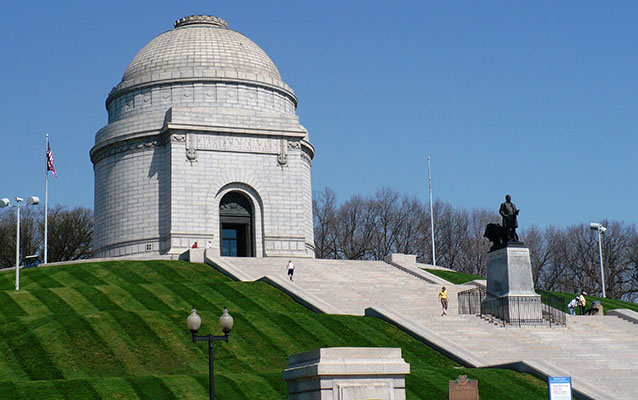Last updated: April 29, 2021
Place
William McKinley Tomb

This large circular, domed mausoleum is the final resting place of President William McKinley.
McKinley was born in Niles, Ohio but he called Canton home throughout his adult life. In 1861, McKinley enlisted as a private in an Ohio infantry regiment and participated in several Civil War battles. After the war he began his career in this city, met his beloved wife, and ran for the highest office of the nation here. He was the last Civil War veteran elected president. His election in 1896 launched an era of Republican dominance that continued until 1910. McKinley governed during a period of intense American expansionism. Domestically, he supported policies that benefitted American business, including high protective tariffs and deflationary fiscal policies.
On September 6, 1901, an anarchist shot McKinley at the Pan-American Exposition in Buffalo, New York. He died eight days later. After lying in state at the United States Capitol, McKinley’s body returned to Canton.
Mark Hanna, McKinley's lifelong friend, political mentor, and manager, and some of McKinley’s friends immediately began planning a suitable memorial. They chose this site in Canton’s Westlawn Cemetery that McKinley once suggested would be an appropriate location for a soldiers’ and sailors’ memorial. The McKinley National Memorial Association, organized in 1901, purchased the site, and appealed to the public for the $600,000 needed to create the memorial. Construction began in 1905. Nine different States donated materials used in the memorial, completed in 1907. Ida McKinley died that year; she lies next to her husband in the memorial chamber. William McKinley Presidential Library and Museum, a private nonprofit organization under the umbrella of the Stark County Historical Society, administers the memorial and its grounds.
The McKinley Memorial that contains the tomb stands on a grass-covered hill overlooking the city of Canton. Designed by architect H. Van Buren Magonigle, the circular, domed pink granite building rises 96 feet above ground and measures 79 feet in diameter. The double bronze doors of the entrance were the largest in the nation at the time of installation. Originally a long, narrow reflecting pool stretched out from the base of the hill in front of the memorial. This feature, together with the 108 stone steps that lead up to the mausoleum, symbolized the President's sword in time of war. In 1951, a depressed lawn replaced the pool, but the sword effect remains. Midway up the steps is a large bronze statue by Charles Henry Niehaus of President McKinley delivering his last speech in Buffalo.
Colored marble laid in a cross pattern forms the floor of the mausoleum. The bodies of McKinley and his wife lie side by side in two polished, dark-green, granite sarcophagi, resting atop a ten-foot-square of polished dark maroon granite in the center of the space. Their two young daughters are also laid to rest here. Three semi-circular arched bays encircle the central chamber. The entablature and frieze extending around the bottom of the dome contain words from McKinley's last speech.
A project through the Save America's Treasures Grant Program, which helps preserve nationally significant historic properties and collections, funded preservation work at the McKinley Memorial in 2000.
